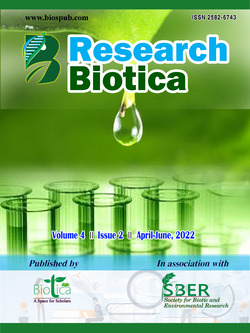
Genetic Variability Analysis of M4-M5 Mutants of Indian Mustard (Brassica juncea L.)
Richa Bora*
Dept. of Plant Breeding & Genetics, Assam Agricultural University, Jorhat, Assam (785 013), India
Priyabrat Hazarika
Dept. of Agronomy, Assam Agricultural University, Jorhat, Assam (785 013), India
S.J. Jambhulkar
Nuclear Agriculture & Biotechnology Division, Bhabha Atomic Research Centre, Trombay, Mumbai (400 085), India
P.K. Barua
Dept. of Plant Breeding & Genetics, Assam Agricultural University, Jorhat, Assam (785 013), India
DOI: https://doi.org/10.54083/ResBio/4.2.2022/51-54
Keywords: Brassica juncea, Genetic advance, Genetic variability, Heritability, Mustard, Short duration
Abstract
Indian mustard [Brassica juncea (L.) Czern. & Coss.] is an important oilseed crop grown in India under diverse agro-ecological conditions in the temperate and subtropical regions during Rabi season. It fits well in the rainfed cropping system with low production cost and high potential to increase edible oil. Farmers in Assam grow rapeseed toria (Brassica rapa) due to its short duration but end up with low yield. Development of short-duration superior Indian mustard varieties is required to increase the average yield of rapeseed-mustard in Assam. Some Indian mustard genotypes were developed by induction of mutations at Assam Agricultural University, Jorhat. In the present study, 143 M4 lines from the parent variety NRCHB-101 of Indian mustard developed through mutation breeding using gamma rays, were evaluated during Rabi 2020-21 followed by 116 M5 selected lines during the Rabi 2021-22 to assess to genetic variability and interrelationships between yield component traits. Significant variation due to genotypes for the characters observed. Moderate genetic variation was observed for seed yield plant-1, number of primary and secondary branches plant-1. Moderate heritability coupled with high genetic advance was observed for number of siliquae in main shoot, number of primary branches, and number of secondary branches. The mutant lines JMM-NRCHB101-37, JMM-NRCHB101-57, JMM-NRCHB101-107 were found to be promising exhibiting superior performance for most of the yield attributing characters. The mutant line JMM-NRCHB101-86 and JMM-NRCHB101-95 also showed potentiality for early maturity with a high yield which could be exploited for the development of early maturing mustard varieties.
Downloads
not found
Reference
Allard, R.W., 1960. Principles of Plant Breeding. John Wileyand Sons Inc., New York. pp. 79-108.
Arifullah, M., Munir, M., Mahmood, A., Ajmal, K.S., Hassan, F., 2013. Genetic analysis of some yield attributes in Indian mustard (Brassica juncea L.). African Journal of Plant Sciences 7(6), 219-226. DOI: 10.5897/AJPS12.031.
Burton, G.W., de Vane, 1952. Quantitative inheritance in grasses. In: Proceeding on 6th International Grass Conservation. pp. 277-283. DOI: 10.12691/wjar-4-6-3.
DRMR, 2020. AICRP-Annual Report-2020. Directorate of Rapeseed-Mustard Research. Available at: www.drmr.res.in. Accessed on: 06 January 2022.
Gomez, K.A., Gomez, A.A., 1984. Statistical Procedures for Agricultural Research. Wiley & Sons, New York. pp. 20-29.
Jambhulkar, S.J., Shitre, A.S., 2009. Mutation induction, evaluation and utilization for development of high yielding varieties in Indian mustard and sunflower: An overview of BARC work. Proceedings of International Conference on Peaceful Uses of Atomic Energy, 2009, Volume 2. p. 327.
Johnson, R.E., Robinson, H.W., Comstock, H.F., 1955. Estimates of genetic and environmental variability in soybeans. Agronomy Journal 47, 314-318. DOI: 10.2134/agronj1955.00021962004700070009x.
Julia, T., Renuka, Th., Nanita, H., Jambhular, S., 2018. Mutagenic effectiveness and efficiency of gamma rays in Indian mustard (Brassica juncea L. Czern and Coss). International Journal of Current Microbiology and Applied Sciences 7(3), 2319-7706. DOI: 10.20546/ijcmas.2018.703.390.
Kumar, H., Anubha, Vishwakarma, M.K., Lal, J.P., 2011. Morphological and molecular characterization of Brassica rapa ssp. yellow sarson mutants. Journal of Oilseed Brassica 2(1), 1-6.
Lyngdoh, Y., Kanaujia, S.P., Shah, P., 2017. Genetic variability, characters association and path coefficient analysis in green mustard (Brassica juncea L.) genotypes. International Journal of Recent Scientific Research 8(8), 19388-19391.
Thakur, A.K., Singh, K.H., Singh, L., Verma, V., Singh, D., 2015. Morphological and molecular descriptors for first Indian mustard hybrid, NRCHB-506. Indian Journal of Biotchnology 15, 116-119.
Tiwari, A.K., Singh, S.K., Tomar, A., Singh, M., 2017. Heritability, genetic advance and correlation coefficient analysis in Indian mustard (Brassica Juncea L). Journal of Pharmacognosy and Phytochemistry 6(1), 356-359.
